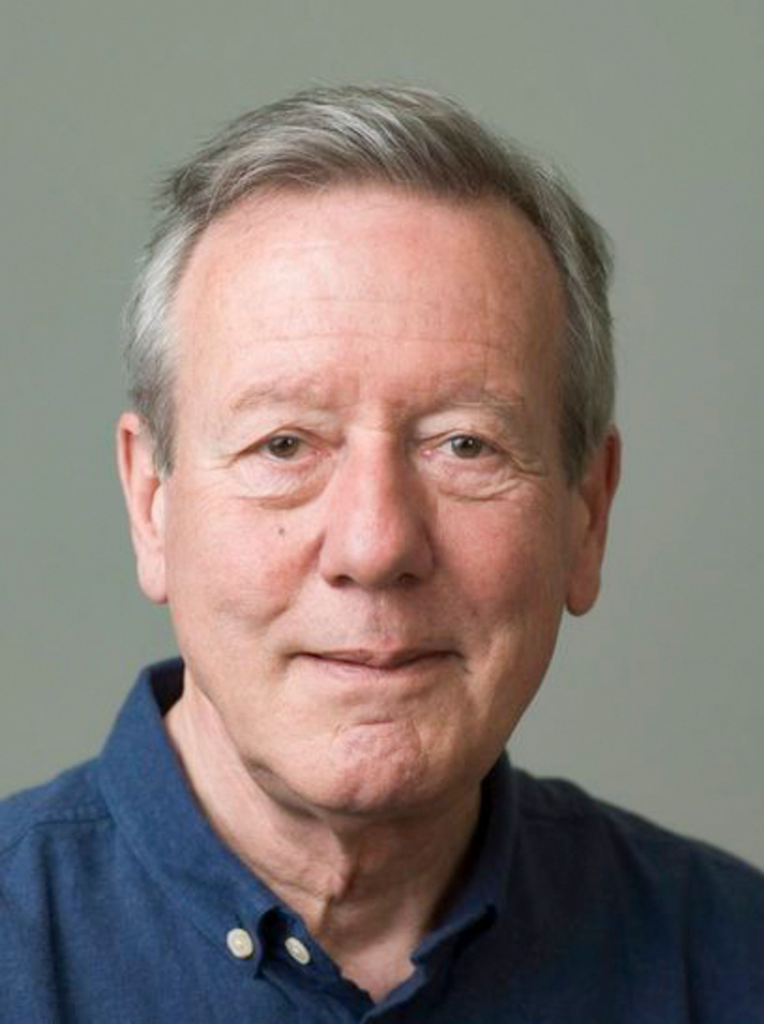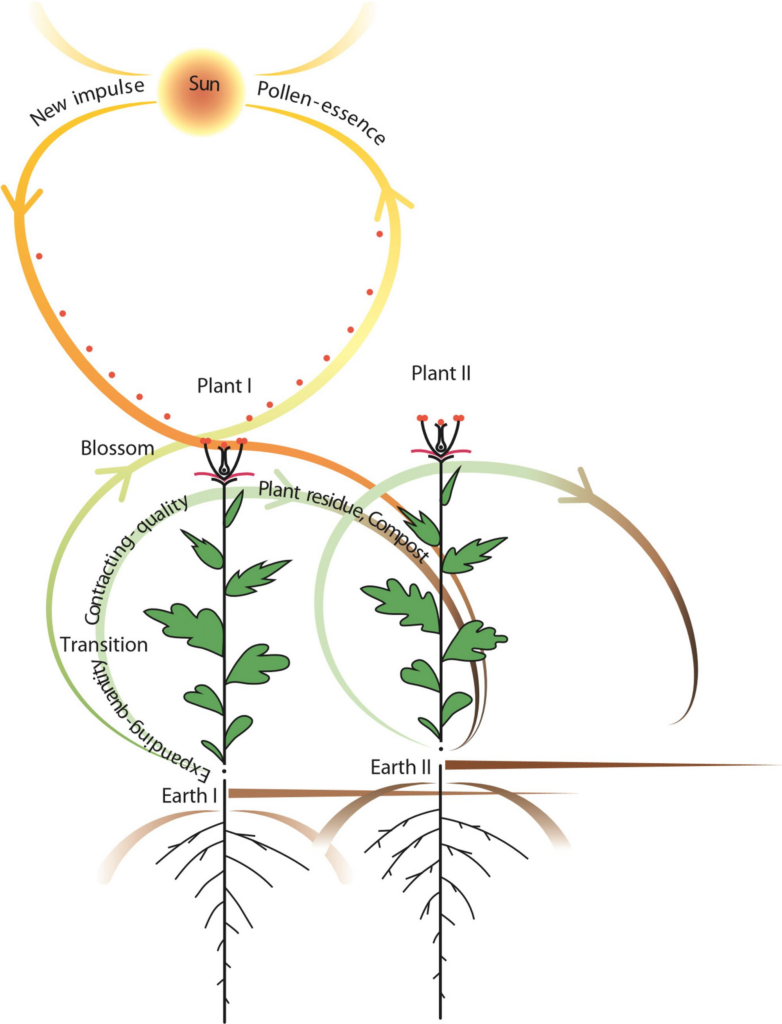Because of our consciousness, human beings are not a will-less “part” of nature, but its responsible, guiding partner. The future of Earth depends on us. How can we see this? Jan Diek van Mansvelt looks at cycles of dying and flourishing through corresponding developmental processes in human beings and plants, to evoke the sort of living thinking that creates a potential for humans and Earth from our imaginative mind.1

How do we think about the end of our life’s work? When our work of many years is completed, we breathe out our last breath, and we die. “It is finished.” Our timeline ends. In our culture, it is a moment often surrounded by sadness: the focus is on the dead body. That worn-out body has been deteriorating over the years—old age comes with a price—but, towards the end, there can be a growing wisdom in the human that is still living and working in that body: their spiritual world continues to grow while their physical existence diminishes. That wisdom is often beyond reason. The person can get by with a few words or with a small gesture, a look of understanding or comfort. Even when their mental capacities have deteriorated, the wisdom of the individual can unexpectedly shine through in brief moments. Then we realise: oh yes, there is the “I”, inside or behind the outer, material manifestation.
For our experience of death and dying, much depends on whether we only see and think about physical reality or whether we experience that a human being is “more” than just matter. In this article, I am searching for words to bring that “more” into focus, to give it a familiar place in my worldview. In doing so, I hope it will become increasingly open for dialogue.
Often, at farewell gatherings in a crematorium, a cemetery, or elsewhere, stories emerge about the person who died and how they were experienced by the people with whom they interacted. “So and so was truly a great person…” All those present get a much broader view of all that the person did during their life. Every human being accomplishes his or her own unique and admirable achievements. They did what was possible for them. They expressed in the sense world what they had in themselves, even if sometimes there’s a lingering impression that they had more in them than they could express in this lifetime. Was that because of the limitations of their outer circumstances? Or was it due to limitations of their inner strength?
Perhaps we should turn death gatherings into great feasts and celebrate what the person who has died meant to us, celebrate what they contributed to the earth and its inhabitants through their many ways of working on Earth. Celebrate! We could shape a celebration that is appropriate for each individual using flowers and dancing, poems and music, and stirring stories—a celebration that is equal to our gratitude for what this special deceased person left us by way of experiences and examples of the realisation of their inner self, of their ideas and intentions, in other words of their spirit, in the earthly substance of the years gone by.
We might wonder how the deceased, who has just crossed over from the material to the spiritual world, experiences our grief—grief which they have blamelessly caused, having definitively finished, or having had to finish, their life’s work once and for all. Of course it grieves us! We miss those who have died. But isn’t that primarily our personal feeling? Does selfishness play a part in that sadness? Do we miss them more strongly, the stronger we were attached to them? How pure was that attachment of ours? How good is it for us? How does love relate to attachment?
We could equally become very happy at their dying if we let the image of all that the person did, all their works, blossom before our inner vision. Through what major or minor knots did they develop themselves step by step? What main lines and side lines on the path of their life become visible, with the corresponding blossoming at the ends? At death, all these timelines end. The soul in question goes “out of time” and blossoms before our inner eyes. Now, their view of their life is timeless, and we can see the whole of it as a panorama before us, just like they can.
From stories of “near death” experiences2 and from what Rudolf Steiner says about the journey of souls who have died, we can try, in our imagination, to sympathize with and experience how the soul that has risen in spirit fares on its passage through the world in which time and space do not exist as we know them. Here, time becomes immaterial space.
Summarising very briefly what I understand of it, the journey of the deceased begins with a panoramic view of their life’s course. What transpired in earthly time as months and years now surrounds them spatially, with all its main lines and side lines. The experience is partly their own memory and partly an experiential awareness of what their actions meant to others at the time and afterward. And they are not alone in this experience—they experience the presence of a being of light who was already there, waiting for them when they passed through the gate of death. It is an Angel, their Angel.
Then, a long journey with this companion begins, step by step, through the planetary spheres, ultimately leading to the solar Being, the one who is called “the light of the world”—Christ. After having experienced the forces inherent in each of the planetary spheres and how they used those forces in their past life, the soul feels the question: Have you achieved your goal? Or do you now realise that you still want more: that you want to become more human?
If “yes” is the answer, “yes, I want to become more human,” then the path travels back down again, back through all the planetary spheres. Enriched with the gifts from those spheres and returning down to the earth, the soul now has to find a human couple that gives it a physical point of contact in which it can incarnate. The egg cell, activated by a sperm cell, then forms the basis for the embodiment or incarnation of that human soul. This first phase of incarnation takes place quite literally “above ground” in the mother’s body, from which the child is nourished by its own self-formed placenta. Only upon birth does the child really come to earth. It comes down to earthly light, earthly space, and earthly time. It breathes air and feeds on milk excreted by the mother—the first form of earthly nourishment. The first inhalation is the start of earth life, just as the last exhalation will be the end of it.
The parents of this life are not the same parents of the previous life. The place on earth is also not the same as that of the previous life, and the earth itself has evolved during that time; it has progressed socially and culturally. How do we see that progress? Not as a repeating cycle but as a spiral development—just as the soul is enriched during its journey through heaven, the earth is enriched during its passage through time: what people and the society that they live in made of it.
Thus, the newborn child, who was spiritually inspired in the solar sphere, connects with the earthly history of the parents to whom it is born and with the history of the place into which it is born. Inspired by the retrospection of its previous life, the child must realize its soul’s new intentions during its lifetime in the here and now of its chosen earthly circumstances. One could describe its intentions and earthly circumstances as two dimensions of its karma or two kinds of karma.
The extent to which a human being, as they grow up and develop, succeeds in acquiring awareness of their self and expanding that awareness in practice determines the extent to which they experience themselves either as a pitiable victim of circumstances or as a spiritual I-being challenged by circumstances. The more a person can direct themselves with their I-being, the freer and more strong-willed they become in their actions. Thus, the more they become truly human and the more fruitfully they can interact with their earthly, social, and cultural environment, until they come from birth to the end of their time and have completed their work on earth. At death, a new future smiles on them, as we saw at the beginning.

The Flowering Plants
Whereas, up until this point, an appeal has been made to our inner vision to see human developmental phenomena in their transcendental context, now we consider the development of flowering plants. Here, the inner view seems remote at first, since nearly everything in a plant’s development meets us outwardly—it is visible, tangible, etc. Direct sensory observation is how we meet the physical plant in all its amazing beauty.
Therefore to address the plant’s living process, I appeal to the reader’s self-conscious, vivid, and compassionate imagination. In doing so, I draw inspiration from Schiller’s statement: “Do you seek the highest, the greatest? The plant can teach it to you. What it is without willing, achieve with your very own will—that’s it!”3 Thus we can take the plant’s natural life course as an example to make our biography our own.
The opening of flower buds brings such joy and wonder: what beautiful shapes and colours spring from the green calyx! Whereas the development of the plant until now took place in green—flat green leaves on a linear green stem—here we encounter a wide palette of shapes, colours, and colour combinations. Where green development required time and patience, flowering is often fleeting: before you know it, the flower has wilted. Whereas the green stem leaves followed each other from bottom to top, each sprouting from its own node on the stem, the flower parts are arranged all together, collectively, on a single flower base. The flower base, which is also the stem top, is a composition of nodes in one plane. Where the stem leaves are flat and two-dimensional, in the flower, something of an inner space is formed by the unity of the petals. It’s nice to see how the three-dimensional character varies by plant species, from the almost totally open Buttercup flower to the almost totally closed fig, which is actually also a flower. And whereas, at germination, the plant grows into time from its “timeless” seed dormancy, at flowering, it goes “out of time” again when it blooms at the end of the green stem, the end of its timeline.
The flower attracts butterflies and bees that come to collect pollen and nectar. From an evolutionary perspective, insects are “higher beings” compared to plants. For example, they can move at will according to their instincts. The pollen they collect and carry high into the air, towards the light, contains the essence of the plant: each plant species has its own unique pollen shape. With its pollen, the plant achieves its greatest spatial expansion using its smallest material extension: the pollen is so small that it is virtually invisible, minimal in its material form. In contrast, the green parts are the plant’s smallest spatial expansion in its most material form. The semi-materialised flower somehow holds a middle between the two.
While the pollen disperses, the ovary remains intact at the base of the flower, even after the flower wilts. That ovary is a metamorphosis of the green stem, just as the colourful flower petals are a metamorphosis of the green stem leaves.4 On the green stem, the leaves extend outwards from the nodes. The ovary also has several nodes, namely ovules, pointing inwards. In the ovary, the plant is turned inwards. However, it cannot go on developing. The metamorphosed stem does not have that power within itself. Only when the pollen of the plant comes down from the sunny light space, reaches the stigma, and grows down into the ovary can it go further, and seeds can form.
The material forming of seeds requires the essence of the plant: the sun-ripened pollen that has been elevated by the insects. The metamorphosed continuation of the plant stem does not out of itself produce new life. However, neither does the plant’s enlightened essence, the pollen. Just as the former needs a light impulse for further development, the latter cannot proceed without a foothold on its way to earth. On the flower base, “above” the green timeline of the stem, the seed is formed from new sunlight and preserved plant life. Only when the seed eventually falls from the stem tip to the soil does the plant itself return to earthly time. Then, after a shorter or longer period, it can germinate, and a new green life begins.
How wonderful to realise that life in the plant was renewed by the sun-enriched pollen impulse while, at the same time, the soil into which the seed falls was also renewed and enriched with the fallen leaves of the plant itself and those from surrounding plants, and perhaps some bird droppings and insect remains. Thus, we find that plant development, like human development, is not circular but spiral—spiraling through the reproduction of the plant and, at the same time, spiraling through the reproduction of the soil.
Title image White rose, from bud to seed. From Wonders of Development by Jan Diek van Mansvelt
Footnotes
- See also: Jan Diek van Mansvelt, Wonders of Development, in Plants, People and Projects, with a contribution of Pieter van der Ree (Adonis Press 2022).
- See Pim van Lommel, Consciousness Beyond Life: The Science of the Near Death Experience (2010) or https://pimvanlommel.nl/en/consciousness- beyond-life/; see also Peter Fenwick and Elizabeth Fenwick, The Art of Dying (2008).
- In Gedichte by Friedrich Schiller (1795).
- See “The Metamorphosis of Plants” by Goethe in Scientific Studies, Goethe: The Collected Works, Volume 12, edited by Douglas Miller (1995).















